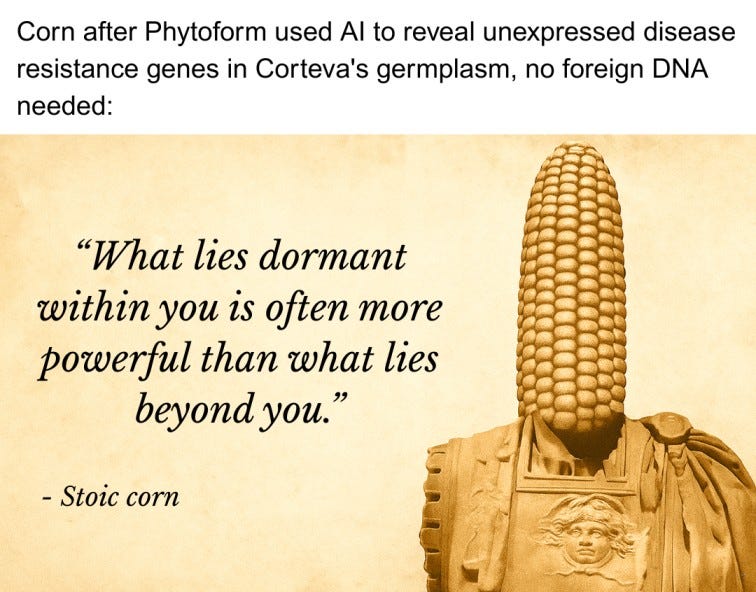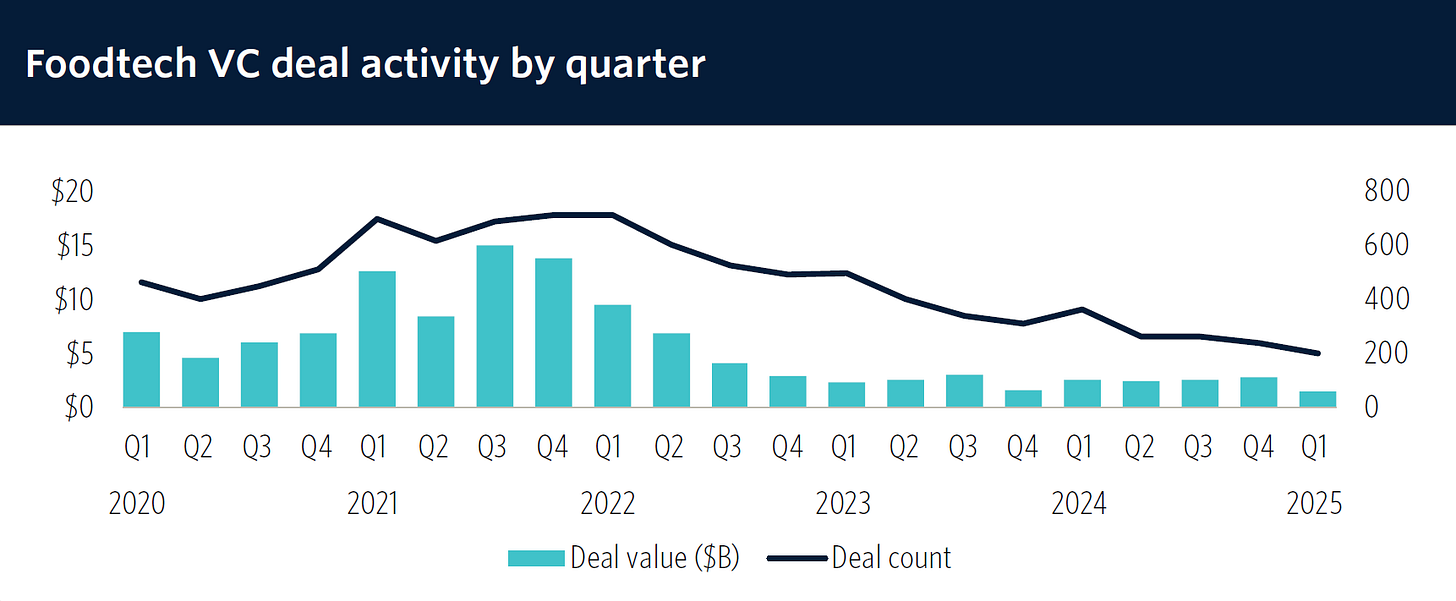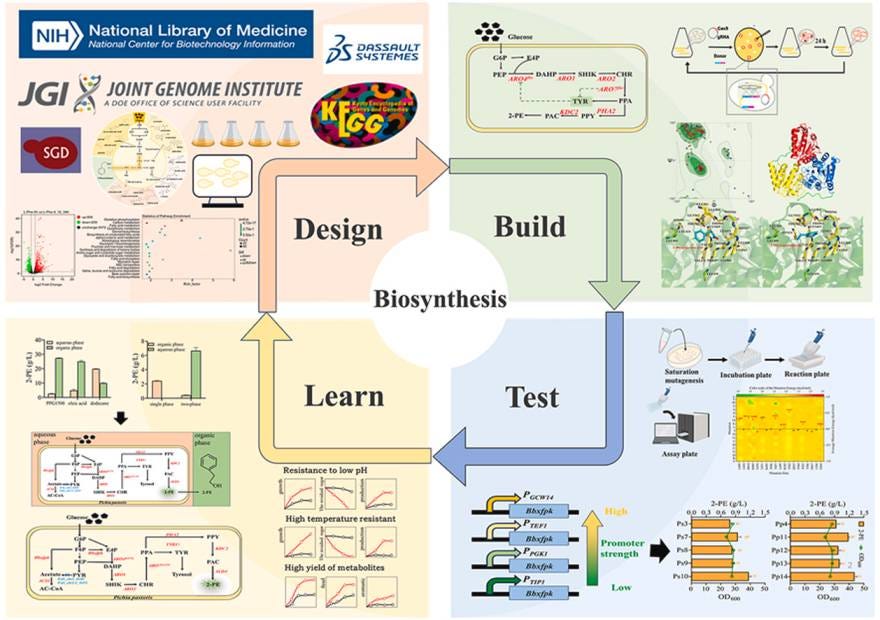$1.4B in Q1 Food Tech VC, AI-Powered Crop Immunity, and Gene Editing for Resilient Small Farms
Also: Everyone who tried Upside Foods’ product at a public tasting opposed cultivated meat bans regardless of political affiliation.
Hey, welcome to issue #107 of the Better Bioeconomy newsletter, your weekly dose of biotech’s latest in food and agriculture. Thanks for being here! 👋🏾
This week, Phytoform and Corteva are teaming up to bring AI-driven gene editing to corn, activating native disease-resistance traits. Over in Wisconsin, GEA opened a massive food tech hub to accelerate cell ag development and scale-up. Pairwise is making its gene editing tools available to global public breeders via CIMMYT, helping smallholders access better crops. Meanwhile, PFx Biotech raised €5M to bring human milk proteins to market via precision fermentation. On the sweet side, researchers achieved record microbial production of brazzein, a sugar-free sweetener. And new data shows VC funding in food tech is down, but not out, with fermentation holding strong.
Let’s dig in!
BIO BUZZ
Products, partnerships, and regulations
🇬🇧🇺🇸 Gene editing startup Phytoform teams up with Corteva to explore AI-driven disease resistance in corn
UK-based Phytoform is bringing its CRE.AI.TIVE platform to corn, using machine learning to sift through millions of DNA control region variations. The aim is to make precise edits that switch on disease-resistance genes, without adding foreign DNA, keeping it outside the GMO category.
The collaboration focuses on two of the biggest corn diseases (names undisclosed) by optimising two native genes already present, but inactive, in Corteva’s germplasm.
It’s Phytoform’s first major corporate partnership and marks a move beyond its earlier work with potatoes and tomatoes, now expanding to corn, one of the most widely grown crops globally.
Source: AgFunder
🤔 Thoughts:
This partnership signals the growing convergence of digital tech and crop science. It’s validation that AI/ML has moved beyond buzzwords and is becoming a core part of how traits are discovered and deployed. More seed and biotech companies are using AI to support everything from trait prediction to optimising growing conditions.
If these tools can compress the timeline from discovery to deployment, we could see a faster cadence of crop improvements, not just for yield, but also nutrition and climate resilience.
It also points to a changing skills mix in agriculture. Companies like Corteva are still building internal R&D, but they’re now partnering with AI-first teams, showing that data science is becoming as crucial as wet-lab science. And as AI tools begin extracting more trait value from existing germplasm libraries, the competitive edge shifts from genetic access to data interpretation.
🇺🇸🇲🇽 Pairwise licensed its gene editing platform to CIMMYT to accelerate crop development for smallholder farmers
Pairwise has licensed its Fulcrum™ gene editing platform, including the SHARC™ CRISPR enzyme, to CIMMYT, a non-profit agricultural research organisation operating in 88 countries. The goal is to speed up crop development for smallholder farmers in 20 focus countries.
Fulcrum includes a range of gene editing tools like cutting, base editing, and templated editing, which help researchers fine-tune crop traits for better performance. The collaboration focuses on crops such as maize, wheat, sorghum, and region-specific staples like pearl millet, finger millet, pigeon pea, and groundnut.
By using Fulcrum, CIMMYT aims to deliver climate-resilient crop varieties more quickly than conventional breeding methods, addressing food security and climate challenges in the Global South.
Source: GlobeNewswire
🤔 Thoughts:
This arrangement bridges a major gap in crop innovation: access. Advanced gene-editing tools, like Pairwise’s proprietary CRISPR platform, are often limited to well-funded companies working on major global crops.
By licensing its Fulcrum™ platform to CIMMYT, a global non-profit with breeding programs in 20 countries, Pairwise is putting cutting-edge biotech in the hands of public researchers. That opens the door for developing improved varieties of regionally important crops, like millets and pigeon pea, that commercial R&D typically overlooks.
If CIMMYT delivers high-performing, edited varieties of millets or pigeon pea within the next few years, it may unlock a flood of interest and funding toward neglected crop R&D.
🇺🇸 GEA opened a New Food Application and Technology Center in Wisconsin to help advance and scale cellular agriculture processes
The 10,000 m² facility includes bioreactors from 50L to 500L, along with full upstream and downstream processing systems for precision fermentation and cell cultivation.
It’s built to support both startups and established food companies, offering the tools and expertise needed to move from lab-scale trials to near-industrial production.
Beyond product development, the center also serves as a learning hub, hosting training sessions and demos to support knowledge exchange and drive progress in food tech.
Source: vegconomist
🇺🇸 Amplifye launches an enzyme designed to boost protein digestion and support better blood glucose control and sleep
The UC Davis spinout, formerly known as Digestiva, has introduced P24, a proprietary enzyme that is activated by stomach acid to initiate protein breakdown earlier in the digestive process. The company says this approach can reduce digestive stress while unlocking benefits like steadier glucose levels and better sleep quality.
Made using precision fermentation, the enzyme works by precisely cutting proteins to boost nutrient availability. P24 increases smaller peptides by about 30% and raises essential amino acid concentrations. This could also activate bioactive compounds in proteins that weren't previously available for absorption.
Lab testing shows solid performance improvements across different protein sources. Using the INFOGEST 2.0 digestive model, P24 boosted protein breakdown by 115% in the stomach phase and 15% in the intestinal phase. Plant proteins showed particularly strong improvements, and consumer trials backed up the lab results with positive feedback on digestion and overall wellness.
Source: AgFunder
🤔 Thoughts:
This breakthrough helps our food work harder for us by extracting more nutritional value from what's already on our plates, rather than just adding more protein or taking extra supplements. The idea is to help our bodies actually use what we're eating more effectively.
At scale, it could ease pressure on protein supply chains, as we'd need less raw protein to achieve the same nutritional benefits. That's potentially helpful for food security when you think about all the "wasted" nutrition that currently passes through us undigested.
Also, by improving the digestibility of plant proteins, P24 could be a critical support pillar for the alternative protein ecosystem by making sustainable diets more nutritionally competitive.
🇺🇸 Everyone who tried Upside Foods’ product at a public tasting opposed cultivated meat bans regardless of political affiliation
In contrast to bans in Florida and five other states, 100% of interviewed attendees at Upside Foods’ Miami tasting opposed cultivated meat bans regardless of political affiliation (Democrats, Republicans, Libertarians), viewing such bans as government overreach and contrary to American values
73% of tasters at Upside Foods' Miami event gave favourable reviews of cultivated chicken, although just as many pointed out areas for improvement, especially its “rubbery” texture.
Another major sticking point was the use of fetal bovine serum. Reactions shifted sharply when some learned that the product was made using fetal bovine serum, underscoring the importance of transparency to consumer trust.
Source: Green Queen
🤔 Thoughts:
This shows how engagement and education can shape public opinion in the novel food space. The numbers speak for themselves: firsthand experience can turn sceptics into supporters. Some attendees who identified as conservatives or DeSantis voters shifted their stance after trying the product.
It also reveals a gap between policymakers and the public, where laws are being passed “on behalf” of consumers, even when informed consumers don’t seem to support them. Going forward, we could see more companies prioritising public tastings and clearer communication, treating consumer education as a key part of bringing novel foods to market.
BIO BUCKS
Funding, M&As, and grants
🌏 Food tech VC investments fell by 36% in capital and 18% in deal count in Q1 2025 compared to the same period last year
With $1.4 billion invested across 202 deals, the data from Pitchbook shows that capital invested also fell by nearly 50% from Q4 2024. There is a strong shift away from early-stage deals, with investors leaning toward startups with proven business models.
Median valuations for early-stage startups have dropped sharply to $6.1M, down from $12.1M in 2021, as fundraising gets tougher and expectations rise.
Still, early-stage alt protein deals, especially in fermentation, are holding up, with notable rounds from Liberation Bioindustries (formerly Liberation Labs), Vivici, and Aleph Farms.
Source: AgFunder
🇵🇹 PFx Biotech secured €5M in funding for precision-fermented human milk proteins
The funding includes €2.5M in seed funding, matching their previous €2.5M EU grant, bringing the Portuguese startup's total recent funding to €5M. The company uses precision fermentation with proprietary microbes to produce human milk proteins that are structurally and functionally identical to breast milk.
PFx Biotech's first product is human lactoferrin, an iron-regulating protein with immune, antibacterial, and anti-carcinogenic properties. The company is targeting markets ranging from infant nutrition to elderly health and sports performance.
The platform can also produce other proteins like bovine lactoferrin, alpha-lactalbumin (which makes up ~25% of breast milk protein), and osteopontin, offering potential benefits across age groups and health needs.
💰 Investors: Buenavista Equity Partners, EIT Food, Beta Capital, and EIC Accelerator (Grant)
Source: Green Queen
🤔 Thoughts:
PFx’s approach reflects a broader industry playbook: start with high-value, low-volume targets to prove the tech and achieve profitability, then expand. Many precision fermentation companies are now following this pattern. Notably, several have pivoted from mass-market proteins to niche ones like lactoferrin because of the better margins.
In the long run, establishing a profitable beachhead with ingredients such as lactoferrin could catalyse improvements in fermentation efficiency and cost, eventually enabling a push into larger volume products.
GEEK ZONE
Latest scientific research papers
🌹 Engineered yeast hits record yield of rose-scented compound with help from computer-guided enzyme design
Researchers engineered Pichia pastoris yeast to produce 2-phenylethanol (2-PE), a rose-scented molecule used in food and cosmetics, by redesigning a key enzyme using computational modelling and fine-tuning metabolic pathways to boost output.
The engineered strain achieved 7.10 g/L of 2-PE production with a 0.14 g/g glucose yield, representing a ~46-fold improvement over unmodified yeast and the highest microbial production reported to date. This was achieved through rational enzyme engineering, smarter pathway routing, and process tweaks to overcome both metabolic and toxicity challenges.
This microbial platform offers an alternative to plant-derived 2-PE, potentially providing a scalable, fermentation-based supply chain that offers a cost-effective and sustainable route for natural flavours in food, fragrance, and cosmetics.
Source: Synthetic and Systems Biotechnology
🍬 Researchers achieved the ‘highest-ever’ microbial titer of sweet protein brazzein using yeast
Brazzein is a low-calorie protein that’s 500–2,000× sweeter than sugar, but sourcing it from plants has been a challenge. In this study, scientists used Komagataella phaffii yeast to produce brazzein, fine-tuning the promoter, signal peptide, and gene copy number to boost output. They tested the system in a 5L fed-batch bioreactor to demonstrate scalability.
The team reached a titer of 639.11 mg/L, reported as the highest level for microbial brazzein production to date. After identifying the optimal PAOX1→SP0030→PbBRZ→Tdas1 expression cassette, key improvements included optimising gene copy number and modulating protein translation, folding, and degradation processes.
This microbial production breakthrough could enable industrial-scale manufacturing of healthy sugar alternatives, offering a new tool for reducing sugar in food and beverage products.
Source: Biotechnology Journal
🌱 Engineered cotton plants produced high-value antioxidant astaxanthin using microalgal enzymes
Researchers engineered upland cotton (variety ZM49) to produce astaxanthin, a high-value red antioxidant pigment. They did this by inserting two microalgae genes (CrBKT and HpBHY), using a constitutive promoter and plastid-targeting peptides to drive pigment production in multiple plant tissues.
The engineered cotton (TY line) accumulated astaxanthin at 61.03 mg/kg in leaves, 7.03–9.28 mg/kg in boll shells, 823 µg/kg in seeds, and 410 µg/kg in cottonseed oil. Pigmentation was visible in leaves, shells, and oil, but not in fibres, even after a four-gene boost aimed at increasing precursor supply.
This marks a breakthrough in demonstrating astaxanthin biosynthesis in cotton, opening up new ways to boost the value of cotton by-products like leaves and seed oil. It also lays the groundwork for future efforts to develop naturally coloured fibres and improve whole-plant utilisation.
Source: Plant Biotechnology
EAR FOOD
Podcast episode of the week
🎧 Innovation alone doesn’t win, ecosystem alignment is the real unlock
Host: Matthew Pryor
Guest: Ron Adner is a professor at the Tuck School of Business at Dartmouth University and the author of two books, The Wide Lens and Winning the Right Game
Great tech isn’t enough, success depends on mobilising the whole ecosystem. Adner makes a key distinction between innovations you can deliver solo and those that only work when advisors, retailers or regulators act with you. Most AgTech tools fall in the second camp, so your strategy must include “co-innovators” (partners who must change what they do) and an “adoption chain” (actors who must buy in for value to reach farmers).
Map incentives as carefully as you map technology. The Michelin run-flat tire failure shows that even a safety-enhancing product can flop if garages earn more by sticking with old tyres. Likewise, agronomists may resist recommending novel biologicals if margins suffer. Diagnose early who could lose money or workflow simplicity, and design around it.
Beware of “ecosystem disruption” that redraws industry borders. A typical disruption replaces one technology with a better one inside the same setup. But ecosystem disruption rewrites the setup itself. Kodak eventually mastered digital photo printing, but still lost when smartphones made printing irrelevant. In AgTech, think about how vision-guided implements could shrink herbicide demand.
Start with a Minimum Viable Ecosystem, and expand by “carry-over.” Focus on the smallest group of partners you need to prove your concept, maybe just one region, one OEM, one data channel. Use that momentum to build outward, instead of launching everywhere at once. It’s more cash-efficient and builds trust faster.
Don’t fall into the “abundance trap.” With so many options like autonomy, biologicals, and carbon analytics, it’s easy to chase everything at once. But pushing big partners to move faster than they’re ready for often backfires. Focus on one slice of the ecosystem, prove your value there, and then grow from a position of strength.
GOT A MINUTE?
If you found value in this newsletter, consider sharing it with a friend who might benefit! Or, if someone forwarded this to you, consider subscribing.
This newsletter is free, but if you'd like to support the time and effort behind each issue, a small pledge is always appreciated.
Thank you, and have a great day!
Disclaimer: The views and opinions expressed in this newsletter are my own and do not necessarily reflect those of my employer, affiliates, or any organisations I am associated with.





Hi Eshan! Thank you for excellent issue #107. Day by day and inch by inch we are making progress to make alt protein widely available to the masses, and your great newsletters help keep your subs in the loop. The community appreciates all your hard work and efforts mate 👍 ❤️